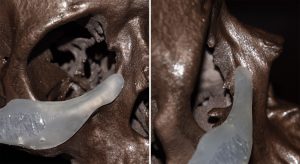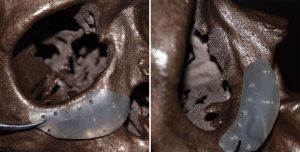One facial area that has caught a lot of attention over the past few years is that of the tear trough deformity. Technically known as the nasojugal grove, it is a skin indentation that begins at the inside of the lower eyelid and extends obliquely downward to the lower rim of the eye socket. While some people have it naturally, most do not and it is usually appears with aging. As the fat of the lower eyelid herniates or becomes protrusive, the depth of the tear trough becomes more apparent and deeper. This leads to the dreaded ‘dark circles’, which often drives patients to some form of treatment.
While the tear trough has been around for a long time and is a well acknowledged deformity, why does it exist and what causes it? On this surface this question may seem somewhat irrelevant, but effective treatments relay on correcting the underlying anatomic problem.
In the June 2012 issue of Plastic and Reconstructive Surgery, a study evaluated the anatomic basis for the tear trough deformity. Through cadaveric facial dissections, an osteocutaneous ligament was found on the upper part of the maxilla which extends up into and through the orbicularis muscle on the inner aspect of the lower eyelid. This is why tear troughs exist and is know going forward as the tear trough ligament. How much of a tethering effect that this ligament has is one major determinant on how prominent the tear trough deformity appears. Other factors creating or exaggerating its appearance is bulging orbital fat above the ligament and infraorbital/maxillary bony retrusion below it.
The most common treatment of the tear trough deformity are injectable fillers, usually hyaluronic-based materials. (e.g., Restylane, Juvederm) By adding volume beneath the tear trough, the soft tissues containing the ligament are pushed outward, softening its appearance. This volumetric approach works best when the tear trough is mild and is very technique-sensitive. Injecting into the ligament and above it just under the skin will actually worsen its appearance.

In cheek lift procedures, dissection should be carried across to the medial orbit rim to release this ligament. This will help soften the tear trough through the pull of the tissues lateral to the orbit over the cheek. Transposing orbital fat into the released tear trough space will help create a more permanent effect.
The tear trough deformity is more than just a simple skin indentation in the lower medial eyelid area. It is there due to the tethering effect of an actual ligament, which is why it changes in appearance with smiling and squinting. Injectable fillers temporarily efface it by adding volume. This is usually a good place to start for more mild tear troughs. Lower blepharoplasties with fat transposition is useful when substantial lower fat herniation (bags) exists. Tear trough implants can be used when one is younger with deep tear troughs and a flatter midface profile. Cheek lifts and ligament release are used as part of a more extensive facial rejuvenation approach in more advanced stages of aging.
Dr. Barry Eppley
Indianapolis, Indiana



